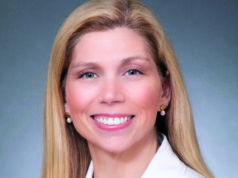
The SVS sub-section on Outpatient and Office Vascular Care (SOOVC) Chair Anil Hingorani, MD, used the group’s dedicated VAM 2024 session to focus on the office-based lab (OBL).
“One of the main things we’ve worked on for the last couple of years is research in the OBL space,” he told those in attendance. “We’ve found that few resources are often available for the OBL. We want to give a platform for people already producing work in the OBL space. Maybe you have a database of your lower extremity angioplasties … venous or access cases. Whatever you’re doing, we didn’t find a place where we could present this work.”
Hingorani revealed the availability of the OBL Handbook, with 18 chapters completed last year and four new chapters added since. The handbook is available for purchase at VAM 2024’s SVS Central outside the Exhibit Hall.
The first three presentations were SOOVC Research Seed Grant projects.
Chong Li, MD, a grant recipient from New York University Langone Medical Center, offered insights from a multicenter perspective study on heparin dosing and safety outcomes during outpatient peripheral vascular interventions.
“Our study aims to investigate the safety and efficacy of low-dose heparin (40 units/ kg) versus high-dose heparin (70 units/ kg) in femoral-based angiograms or venograms,” Li explained. “The objective is to demonstrate the safety of a consistent antithrombotic practice with low heparin dosing compared to high dosing during peripheral endovascular interventions in an outpatient setting.”
The study’s first stage involved a retrospective review of data collected by the Vascular Care Group, encompassing seven practices across three states and involving 21 vascular surgeons from 2022–23. Expected to cover 200–300 cases, the study will assess primary endpoints, including ischemic and bleeding complications, and secondary endpoints, including procedural duration and recovery time.
“The evidence for heparin dosages is largely from the coronary literature, much of which is dated from inpatient settings or European countries. This study aims to improve procedural safety outcomes by reducing bleeding and ischemic complications while maintaining safety and efficacy,” said Li.
Margaret Tracci, MD, a professor of surgery at UVA at Charlottesville, Virginia, concluded the session by discussing malpractice protection in OBLs.
Unlike hospitals and ambulatory surgery centers (ASCs), OBLs have notable differences in payment structures and regulatory requirements, she said. These labs have fewer resources, and do not have anesthesia services, operating rooms (ORs), blood banks or intensive care units (ICUs). The equipment and supplies available in OBLs are also more limited compared to more extensive medical facilities.
“Safety and patient selection are fundamental in the OBL setting,” Tracci said. “Key principles include understanding the resources and capabilities of the facility, careful case selection and having a robust plan for potential complications.”
She highlighted several key strategies to avoid complications in the OBL setting, and the cornerstone of which is patient selection. She noted that carefully considering patient characteristics and case or lesion specifics is crucial. She also discussed minimizing risk using minor, safe access points, and employing preventive measures such as embolic protection and intravascular ultrasound (IVUS).
Tracci advised having robust protocols for resuscitation, airway management, vascular salvage and patient transfer. Key equipment, such as thrombectomy catheters and medications, should always be accessible, she said. Establishing hospital privileges and transfer agreements is essential to facilitate smooth and efficient patient transfers when needed, Tracci added.
“Nobody is always both lucky and good, so you will have complications. So how do you avoid both the bad outcomes and the lawsuit? Catch your complications. Check the feet before the patient goes home. Maybe do that really good discharge instruction, telling them what to call for if something’s not quite right at home. Do the phone call,” she said.












